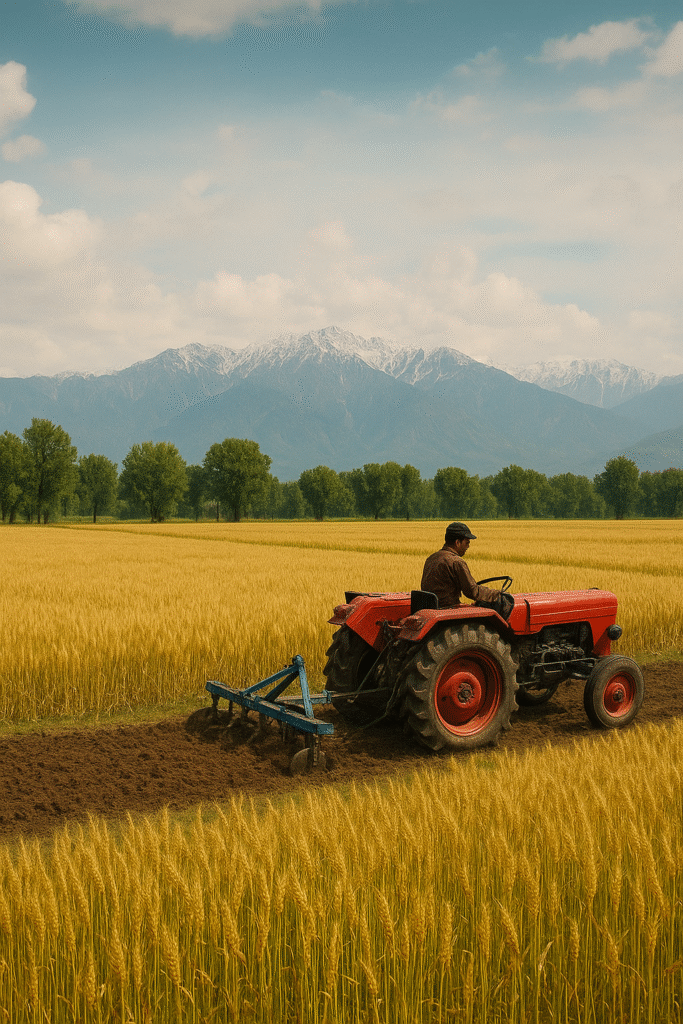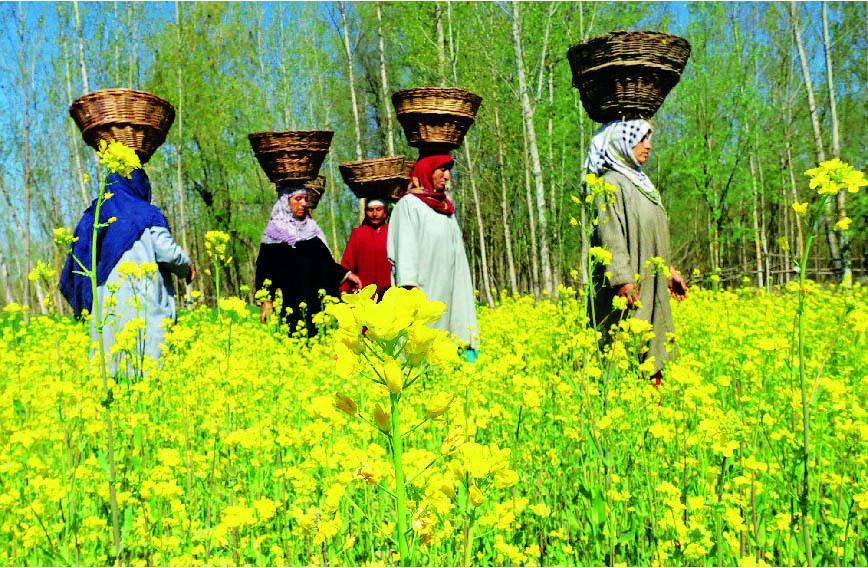By Riyaz-Ullah
The geography of Jammu and Kashmir is as diverse as its people. From the subtropical plains of Jammu to the cool temperate climate of the Valley, the region offers a natural advantage for agriculture. In Jammu, rice, maize, and wheat dominate the fields, ensuring food security for local populations.
The Kashmir Valley, on the other hand, has carved its reputation as a horticultural powerhouse. Its apples—crisp, juicy, and aromatic—are shipped across India and increasingly find their way to global markets. Alongside apples, the valley produces pears, cherries, apricots, and walnuts, each contributing significantly to farm incomes and regional exports.
Among the crown jewels of Kashmiri agriculture is saffron, grown in the famed Pampore fields. Known as the “red gold,” Kashmiri saffron commands one of the highest prices in the world for its purity and quality. Alongside these, pulses, oilseeds, and vegetables also add to the agricultural basket of the Union Territory, sustaining both household consumption and market supplies.
Livestock and Dairy
If crops are one pillar of the agrarian economy, livestock rearing is the other. Sheep, cattle, and goats are central to the livelihoods of thousands of families. Sheep rearing, in particular, is a traditional occupation, producing wool, mutton, and dairy products that feed local markets and sustain rural households.
Nomadic communities such as Gujjars and Bakarwals continue their centuries-old practice of seasonal migration, moving livestock to high-altitude pastures in summer and descending to plains in winter. This pastoral tradition, enabled by the region’s vast meadows and alpine landscapes, makes J&K one of the prime zones for dairy and livestock products like milk, ghee, and cheese.
The sector not only feeds the population but also stimulates economic growth by activating local markets and offering employment where industrial opportunities remain scarce.
Employment and Livelihoods
Agriculture is the single largest source of employment in Jammu and Kashmir. More than 70 percent of the population depends directly or indirectly on farming, livestock, or allied activities. In rural areas, it is often the only source of income.
The landholding pattern, however, reflects inequality. A small section of landowners hold vast tracts of fertile land, while the majority operate with smallholdings measured in kanals. Then there are the landless, often from marginalized communities, who survive as agricultural laborers. This stratification shapes rural society, dictating access to resources, opportunities, and income.

Despite these challenges, the sector sustains millions, keeping rural economies alive and shaping the standard of living. For this reason, agricultural land in J&K must be preserved and utilized judiciously, rather than lost to unchecked urbanization and construction.
The Challenges on the Ground
For all its importance, agriculture in J&K faces significant hurdles. Productivity remains low because many farmers continue to rely on traditional methods rather than adopting modern techniques and high-yielding varieties (HYVs). While the region has abundant rivers and streams, irrigation facilities remain inadequate, forcing heavy dependence on rainfall and leaving farmers vulnerable to erratic weather and climate change.
Poor infrastructure adds to the woes. Disruptions in transportation, frequent road blockades, and lack of cold storage facilities often result in massive post-harvest losses. Perishable products like fruits suffer the most, eroding farmer incomes.
Another pressing concern is the misuse of fertilizers and pesticides. Without proper guidance, farmers often apply chemicals incorrectly, harming both yields and soil health. Compounding this is the high cost of quality seeds, manures, and agro-chemicals, which many small cultivators simply cannot afford.
Urbanization presents an additional threat. Fertile agricultural land is being converted into residential colonies and commercial complexes at an alarming pace. This not only reduces the agricultural base but also deepens unemployment, as alternative job opportunities remain limited.
Initiatives and Support
Recognizing these challenges, the government has introduced several schemes to modernize the sector. Programs like the Kisan Credit Card and PM-Kisan Samman Nidhi provide financial support to farmers. The Mission for Integrated Development of Horticulture (MIDH) promotes high-value crops, while the Pradhan Mantri Krishi Sinchai Yojana (PMKSY) focuses on efficient water use and irrigation expansion.
Yet, policy interventions often fail to trickle down effectively to the grassroots. Farmers complain of delays in subsidy disbursals, lack of awareness about schemes, and bureaucratic hurdles. To bridge this gap, agricultural extension services must be strengthened, ensuring that knowledge and resources reach the smallest cultivators.
There is also a pressing need to engage the youth. Increasingly, young people in rural areas are moving away from agriculture, seeking jobs abroad or in urban centers. Making agriculture profitable, technologically advanced, and market-linked could reverse this drift.

Organic farming is one area with untapped potential. With global demand for organic produce rising, shifting toward chemical-free practices could open new premium markets for J&K’s products. Similarly, precision farming, using satellite data, sensors, and modern irrigation methods, could boost efficiency while conserving resources.
The Way Forward
To unlock the full potential of agriculture, J&K must go beyond production and invest in agro-industries. Processing units for fruits, vegetables, and dairy products would add significant value to raw produce, creating jobs, curbing wastage, and expanding export opportunities. Cold chains, efficient transportation, and modern market infrastructure could transform the way farm goods reach consumers.
Global markets already recognize the brand value of “Kashmiri” products like apples, walnuts, and saffron. With better infrastructure and promotion, these could become global icons, much like Darjeeling tea or basmati rice.
But achieving this requires a fine balance: preserving traditional practices where they add value, while embracing technology and sustainability for long-term growth.
Agriculture in Jammu and Kashmir is more than an economic sector—it is the lifeline of society, shaping culture, livelihoods, and identity. Its diversity, from saffron fields to apple orchards and alpine pastures, is unmatched. Yet, challenges of low productivity, poor infrastructure, and urban encroachment threaten its future.
With targeted government support, technological integration, and a shift toward agro-industries, agriculture can become the engine of growth for the Union Territory. By protecting fertile land, empowering small farmers, and linking rural producers to global markets, J&K can not only sustain its people but also revive its economic glory.
In the end, as generations of farmers in the region have known, agriculture is not just about growing crops—it is about sustaining life. For Jammu and Kashmir, it will continue to be the heartbeat of the economy and the anchor of its rural-urban balance.
The views expressed in this article are solely those of the author and do not necessarily reflect the opinions or views of this newspaper